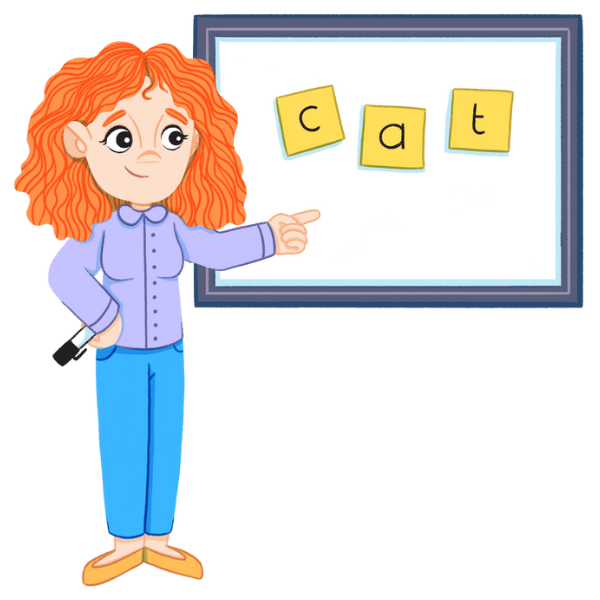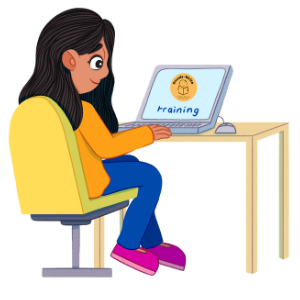Sounds-Write Practitioner Training
Join our flagship courses to gain a comprehensive understanding and the hands-on experience to put the Sounds-Write approach to literacy into practice from day one.

What is Sounds-Write?
Sounds-Write is an expertly structured synthetic phonics programme based on the science of reading. This multisensory, code-oriented, comprehensive approach to literacy instruction has been designed by teachers—for teachers.
For twenty years, we’ve been delivering our high-quality training programme to empower educational professionals to do one of the most important jobs: teach children to read and write.
Want to discover more about Sounds-Write? If so, get comfortable and sit down with Naomi, Head of Training, while she explains everything you need to know about Sounds-Write.

A training-based programme
At Sounds-Write we believe teacher knowledge is crucial to ensure success. After all, the single greatest factor in improving student outcomes is strong teacher knowledge.
There are many phonics schemes and resources out there, but Sounds-Write focuses first and foremost on developing teacher knowledge. Drawing on well-established theories of learning and teaching, Sounds-Write empowers educators with the knowledge and confidence to forge a brighter future for their students.
What does the training cover?

Learn how to teach the skills, concepts, and code knowledge students need to master in order to become competent readers, writers, and spellers.

Discover how to introduce them to the Initial Code in the first year of school, moving from CVC words to words with a progressively more complex structure, and then transitioning to learning the Extended Code, alongside polysyllabic words in Y1.

Learn how to teach all the different Sounds-Write lessons (or activity types), and have ample opportunity to practice them yourself.

Find out how to teach Sounds-Write to groups of different sizes, so you can work with the whole class, small intervention groups, or one-to-one.

Learn how to teach through errors—one of the cornerstones of the Sounds-Write approach—and how to conduct formative assessment and use differentiation as an integral part of your teaching.

Understand how to use diagnostic tools to determine where new students should start the programme.
Training to suit your schedule
We understand that training alongside your other day-to-day responsibilities can be challenging. That’s why we’re happy to be able to offer online training as well as face-to-face.
Online
The Sounds-Write Practitioners’ Online Training has been designed by John Walker, the author of the Sounds-Write programme, together with experts in online learning, based on the science of reading and the science of learning. It comprises presentations, lesson demonstrations and a range of other activities and content. The course includes a robust rationale for linguistic phonics and covers the theoretical underpinnings of the programme. There are quizzes and online assignments that you must complete to gain a course certificate.
There will be a cohort of trainees doing the course with you. The course will be led by one or more Sounds-Write trainers, who will answer your questions, provide feedback on assignments and run Zoom sessions to support you during the course.
The course lasts 6 weeks.
Face-to-face
The face-to-face course was written by John Walker, the author of the Sounds-Write programme, together with experts in online learning, based on the science of reading and the science of learning. It has been taught for over 20 years by a team of knowledgeable and experienced trainers. The course includes a robust rationale for linguistic phonics and covers the theoretical underpinnings of the programme, as well as lesson demonstrations, practical activities and guidance for implementation in your setting.
Your face-to-face experience will be with a small cohort of trainees (up to 24) so that your trainer is able to get to know you, giving you bespoke feedback on your practice and answering your questions about your setting.
The course takes place over 4 days.
What do teachers and teaching assistants think?
Teachers’ subject knowledge and therefore their confidence with teaching phonics has vastly improved since the implementation of Sounds-Write. The skills taught through the programme are transferable throughout the curriculum with improved reading, writing and spelling from our children.
FAQs
How much does the training cost?
The online training costs are £490 (+ VAT) in the UK, $1089 AUD (incl GST), in Australia, $900 USD (+ sales tax) for the USA and $1200 CAD (+ sales tax) for Canada. For the rest of the world, please enquire. Face-to-face courses cost £490 (+VAT) in the UK, and around $1089 AUD (incl GST) in Australia, depending on location. There may be occasions where a small additional fee may be added to a face-to-face course to cover travel expenses for the trainer. This would be made clear prior to confirming your booking.
The prices shown above are for our comprehensive Sounds-Write packages which offer tailored solutions for Practitioners’ Training, allowing you to choose the option that best fits your unique requirements. Experience the added value of lifetime access to the Sounds-Write Practitioners’ Portal and a range of exceptional benefits carefully curated to enhance your learning journey. These packages seamlessly integrate training, support, and complementary resources under one simple training fee. Discover more here.
Participants receive the Sounds-Write manual, which contains all the lesson scripts, word and sentence lists and texts needed to teach the programme from Reception/ Kindergarten all the way up. On completion of the course, participants gain unlimited access to additional downloadable resources and documents.
There are no ongoing costs other than the initial training costs. We are a training-based programme rather than a resource-based programme, and we strongly believe that knowledgeable staff, rather than gimmicky resources, is the key to ensuring that all students learn to read and spell and can reach their potential.
How does the Practitioners' Online Training work?
The Sounds-Write Practitioners' Online Training has been designed by John Walker, the author of the Sounds-Write programme, together with experts in online learning, based on the science of reading and the science of learning. It comprises presentations, lesson demonstrations and a range of other activities and content. The course includes a robust rationale for linguistic phonics and covers the theoretical underpinnings of the programme. There are quizzes and online assignments that you must complete to gain a Course Certificate.
There will be a cohort of trainees doing the course with you. The course will be led by one or more Sounds-Write trainers, who will answer your questions, provide feedback on assignments and run Zoom sessions to support you during the course.
The course lasts 6 weeks.
The Course, Week-by-Week
Week 0: approximately 2 hours of work: this is mainly to enable you to find your way around the platform, introduce yourself and meet your trainer and other trainees. The course includes a discussion forum where you will be able to ask questions, and where you will contribute to some course discussions.
Weeks 1-4: approximately 8 hours of work per week. You will have to cover the content of that week during that week, and you will also need to complete all the assessment tasks for each week by the end of that week. Three of the compulsory assignments involve you videoing yourself demonstrating some of the Sounds-Write activities and sharing these on the course for peer feedback.
Week 5: approximately 2 hours of work: this week has no formal new content, but you will be able to revisit anything in the course before the course closes. At the end of week 5, the course website will close and you will no longer have access to the online course.
The course is asynchronous, but there are 4 synchronous sessions online during the course, using the Zoom platform. These sessions will be organised by the trainers on the course. These will take the form of a live Q&A, and also provide the opportunity to consolidate your understanding. For those who cannot attend the live sessions, these will be recorded and made available to all during the course.
What equipment will I need for the Practitioners' Online Training?
To access the course and do the course activities, you will need access to a PC or laptop (including Mac). You should not do the course on your phone or on a tablet, as some of the quiz activities will not work well. Your computer should have Chrome or Firefox as the preferred browsers (please note that the course will not be fully functional with Microsoft Edge, and that you might not be able to complete parts of the course if this is your only available browser)
You will need a connection speed good enough and stable enough to watch the course videos.
If you are accessing the course website from school or work, it is your responsibility to check with your IT manager that the firewall at your school/workplace will enable you to access external content, i.e. the content from our course platform.
You will need a notebook to write in, and it is important you take notes on the course as you go along.
For some activities, you will need to video yourself. You can use the camera on your laptop or a mobile phone. The format you will need to submit your videos in is: .mov .avi or .mp4 format.
In order to do the course, you will need to have basic ICT skills. You will need to be able to do the following:
- film yourself on your camera/laptop and upload a video following simple instructions,
- take part in forum discussions,
- access and take part in Zoom meetings,
- complete drag and drop and multiple-choice quizzes,
- bookmark pages
If you are not sure the course is right for you, or that you have the time, equipment or computing skills to do the job, please do this quiz now and check our advice
How do I book onto a training course?
If you are looking to undertake training before September 2023, please head straight to the face-to-face or online course dates pages, choose your course and fill in the booking form provided. Once your booking form is submitted, your trainer will contact you to organise payment and answer any further queries you may have.
In September 2023, we are launching package deals for booking the Sounds-Write Practitioners’ Training, meaning you can choose the best package to suit your individual requirements. Not to mention the fantastic additions included in the training packages, such as lifetime access to the Sounds-Write Practitioners’ Portal! You can view the packages here, once you have chosen your package, you will then be directed to the available course dates to fill in the booking form. Once your booking form is submitted, your trainer will contact you to organise payment and answer any further queries you may have.
If you’d like to speak to someone before confirming your booking, please don’t hesitate to get in touch with us. We’ve got a friendly team who are happy to answer any questions you may have.
Does Sounds-Write meet the Early Learning Goals (2021) for England?
Yes, Sounds-Write meets all the 2021 Early Learning Goals for Literacy for comprehension, reading and writing. Find out more here.
Is Sounds-Write only appropriate in the early years?
Schools usually start Sounds-Write in Reception/Kindergarden with children aged 4, where they cover the Initial Code.
In Years 1 and 2 students continue to deepen their knowledge and understanding of how the alphabetic code works through the Extended Code ('first spellings' and 'more spellings') and become familiar with the strategies to read and write polysyllabic words.
In Years 3-6, Sounds-Write continues to build on the hard work undertaken from the Early Years to Year 2. Our advice is to review the Extended Code 'more spellings' again in Year 3. This is for the benefit of that 50% of students that really need more practise and exposure to apply the sound-spelling correspondences successfully and correctly.
In Years 3-6 we use the Extended Code to deepen students understanding of spelling, usually through words that are relevant to the curriculum – these can be taught within sound units to help students make connections, see patterns, etc
We also use the polysyllabic lessons to teach more complex polysyllabic words. Skills continue to be practised, reinforced and extended into polysyllabic words.
Words in Y3-6 are taught using the Sounds-Write approach to ensure consistency of approach and to ensure familiarity throughout the school.
Through the different lessons (or activity types) of the Extended Code and Polysyllabic Words, students hone their spelling through interleaving, spaced learning, retrieval, repetition and practice to make sure that they achieve mastery in reading and spelling.
What is the Sounds-Write scope and sequence?
Sounds-Write teaches the skills, concepts and code knowledge necessary to teach children to read and spell from Reception/Kindergarten to Y6, and can also be used in intervention settings at any age.
Sounds-Write teaches the complete code (175+ of the most common spellings of the 44 or so sounds in English) through our Initial Code and our Extended Code. We also teach students to read and write polysyllabic words.
Details can be found in these three documents:
What professional development and further support can Sounds-Write provide once I've trained?
As well as providing coaching sessions upon request, Sounds-Write has a number of ways that we support practitioners. Our Facebook groups are a great place to ask questions and discuss topics you might need help with. We run a year-round webinar series for practitioners to gain insight into specific areas of teaching phonics, such as planning, fidelity and intervention. Sounds-Write also provides several professional development courses including the Masterclass for Phonics Leads and the Masterclass in teaching phonics as an Intervention. In addition to all of this, we post regularly on social media, pointing practitioners in the direction of further reading and research that will improve your practice.
